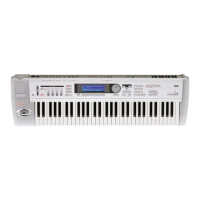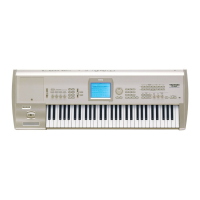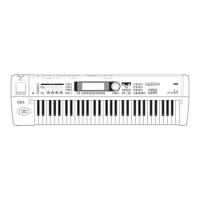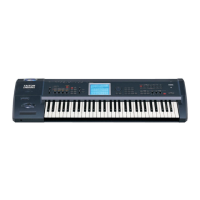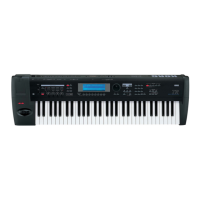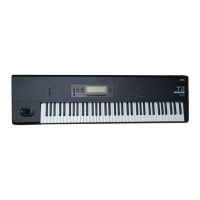5. Sequencer mode
41
STEP 3
5. Sequencer mode
To enter Sequencer mode, press the front panel [SEQ] key.
Here you can use the sequencer to playback or record songs, and edit recorded data. You can also
record and edit patterns.
Before editing sequencer song data, you must first turn off the protect setting in Global mode
(☞page 51 in this manual).
About the TRINITY’s sequencer
• Up to 20 songs can be created.
• Each song can have its own patterns (up to 100).
• Up to 80,000 events (notes, etc.) can be used.
• There are 16 tracks for music data, and a master track to control these tracks (time signature,
tempo, etc.).
• Up to 999 measures can be used.
• Timing resolution is q /192.
• Effect settings can be made for each song.
• Up to 8 insert effects can process the audio output of individual tracks, and two master effects
can process the overall audio output.
• You can name songs as well as patterns and tracks.
• You can save the created songs in a special format, and transmit them using MIDI Data Dump
messages.
• Song data that you create can be saved to floppy disk as Standard MIDI File data.
• Musical data saved in Standard MIDI File format can be loaded and played back by the TRIN-
ITY’s sequencer.
• When the Track Status is set to EXT or BOTH, the TRINITY’s sequencer can play external tone
generators.
• When the Track Status is set to INT or BOTH, an external sequencer can play the TRINITY’s
multi-timbral tone generator.
• You can use various recording methods such as Realtime Recording which records your per-
formance just as you play it, or Step Recording which allows you to “type in” the musical data.
• You can perform various editing operations (event editing etc.) on the musical data that you
recorded.
• Combination settings can be copied to a song.
• If the separately sold HDR-TRI option is installed, audio such as vocals or guitar can be digi-
tally recorded on an audio track.
• For playback or recording, desired tracks can be muted.
• Alternate Modulation or Dynamic Modulation can be made to follow tempo changes.
• You can fast-forward or rewind while listening to the sound.
How a song is organized
Each song consists of initial settings with which the song begins, and the playback data of the
song itself.
The 16 sequence data tracks, the audio tracks of the hard disk recorder, the control tracks for the
hard disk recorder, and the master track are also organized into initial settings and the playback
data.
The audio tracks are available only if the HDR-TRI option is installed.
Track Initial settings Playback data
Tracks 1–16
program numbers, vol-
ume, pan, etc.
program change, note on/off, bender,
pattern no., etc.
Audio tracks 1–4 audio data
Control tracks for audio tracks 1–4 volume, pan, etc. volume, pan, etc.
Master track time signature, tempo time signature tempo
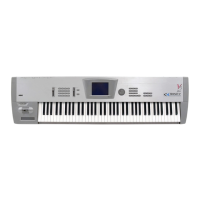
